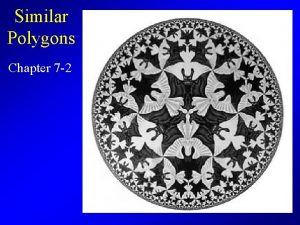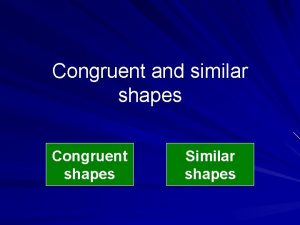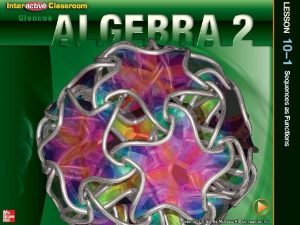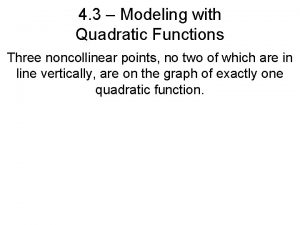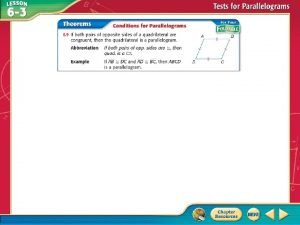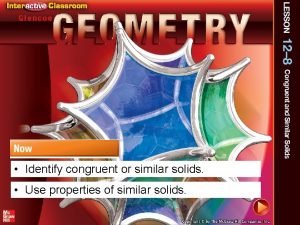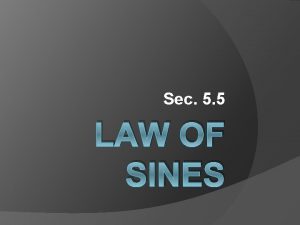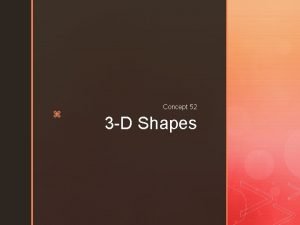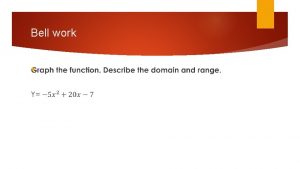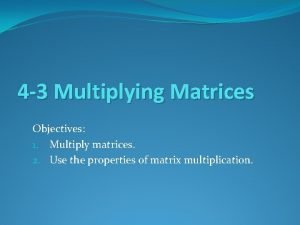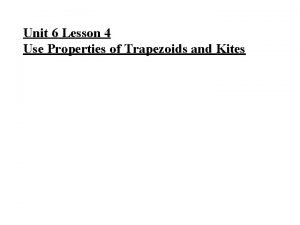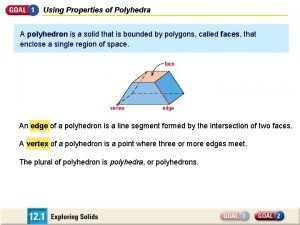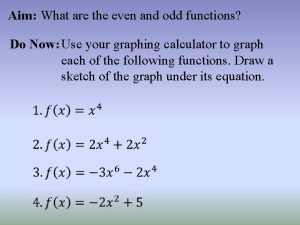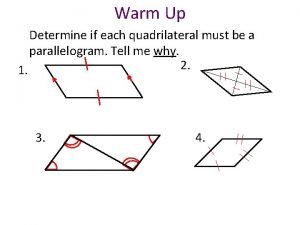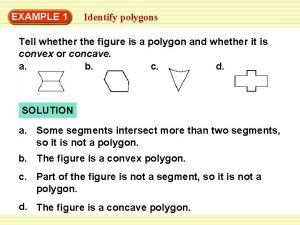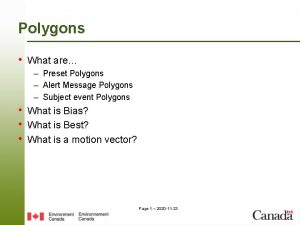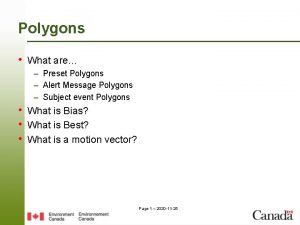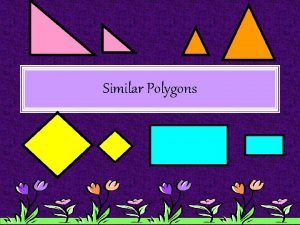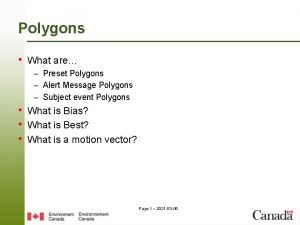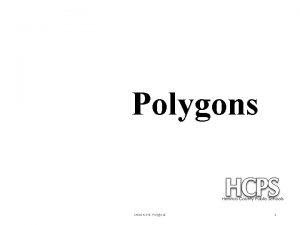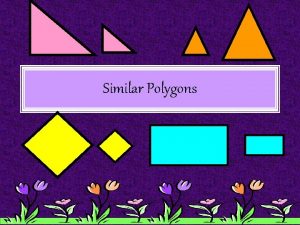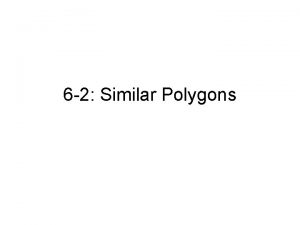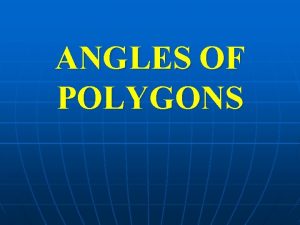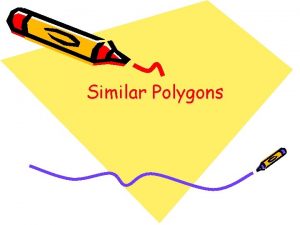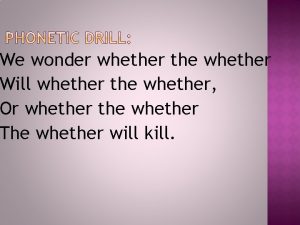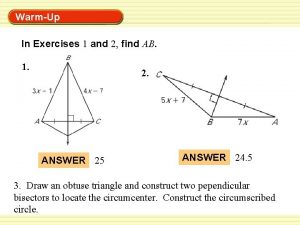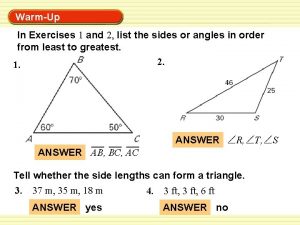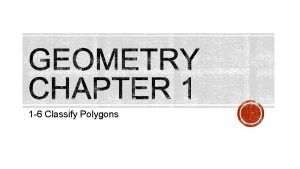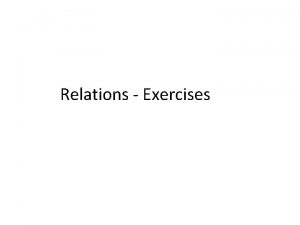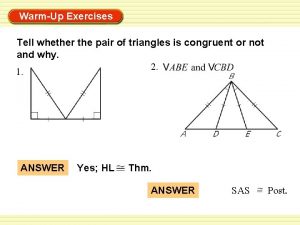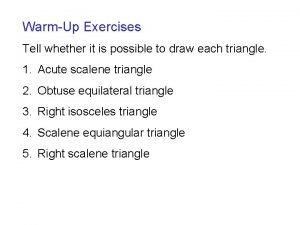WarmUp Exercises 1 Determine whether the polygons are


















- Slides: 18

Warm-Up Exercises 1. Determine whether the polygons are similar. If they are, write a similarity statement and find the scale factor of EFGH to KLMN. 2. In the diagram, of x and y. 6 DEF ~ HJK. Find the value y

Activity: p. 366 Explore Properties of Dilations • You will need graph paper, protractor/ruler. • Complete #’s 1 -5 • Findings:

Lesson 6. 2 Transformations & Similarity

EXAMPLE Warm-Up 1 Exercises Describe a dilation FEG is similar to moves FEG onto FDH. Describe the dilation that FDH. SOLUTION The figure shows a dilation with center F. The scale factor is 2 because the ratio of FH to FG is 20 : 10, or 2 : 1.


EXAMPLE Warm-Up 2 Exercises Describe a combination of transformations ABC is similar to FGE. Describe a combination of transformations that moves ABC onto FGE. SOLUTION A dilation with center B and scale factor 2 moves ABC onto DBE. 3 Then a rotation of DBE with center E moves DBE onto FGE. The angle of rotation is equal to the measure of C.

Warm-Up Exercises GUIDED PRACTICE for Examples 1 and 2 The two figures are similar. Describe the transformation(s) that move the blue figure onto the red figure. 1. 2. ANSWER dilation with center 7 B and scale factor 3 ANSWER 2 dilation with scale factor 3 and reflection

EXAMPLE Warm-Up 3 Exercises Use transformations to show figures are not similar Use transformations to explain why ABCDE and KLQRP are not similar.

EXAMPLE Warm-Up 3 Exercises Use transformations to show figures are not similar SOLUTION Corresponding sides in the pentagons 2 are proportional with a scale factor of 3. However, this does not necessarily mean the pentagons are similar. A dilation with center A and scale factor 2 moves ABCDE onto 3 AFGHJ. Then a reflection moves AFGHJ onto KLMNP does not exactly coincide with KLQRP, because not all of the corresponding angles are congruent. (Only A and K are congruent. ) Since angle measure is not preserved, the two pentagons are not similar.

How to Construct a Dilation of an Object • Hand-out • Draw an object and select a center of dilation. • The center of dilation can be anywhere and is also referred to as a fixed point.

EXAMPLE Warm-Up 4 Exercises Use similar figures GRAPHIC DESIGN A design for a party mask is made using all equilateral triangles and a scale factor of 1. 2 a. Describe transformations that move triangle A onto triangle B. b. Describe why triangles C and D are similar by using the given information.

EXAMPLE Warm-Up 4 Exercises Use similar figures SOLUTION a. The figure shows a dilation with scale factor 1 2 followed by a clockwise rotation of 60°. b. Triangles C and D are similar because all pairs of corresponding sides are 1 proportional with a ratio of 2 and all pairs of corresponding angles of equilateral triangles have the same measure.

Warm-Up Exercises GUIDED PRACTICE for Examples 3 and 4 Refer to the floor tile designs shown below. In each design, the red shape is a regular hexagon.

Warm-Up Exercises GUIDED PRACTICE 3. for Examples 3 and 4 Tile design 1 is made using two hexagons. Explain why the red and blue hexagons are not similar. 4. Tile design 2 is made using two similar geometric shapes. Describe the transformations that move the blue hexagon to the red hexagon. 5. Tile design 3 shows congruent angles and sides. Explain why the red and blue hexagons are similar, using the given information. 6. If the lengths of all the sides of one polygon are proportional to the lengths of all the corresponding sides of another polygon, must the polygons be similar? Explain.

Warm-Up Exercises GUIDED PRACTICE for Examples 3 and 4 SAMPLE ANSWER 3. The red hexagon has all sides congruent, but the blue hexagon has 3 shorter sides and 3 longer sides, so ratios of corresponding side lengths are not constant. 4. dilation followed by a rotation of 30° about the center of the figures 5. All angles are congruent, so angle measure is preserved, and all side lengths are congruent in each hexagon, so the ratio of any two corresponding side lengths is constant. 6. No; even though corresponding sides might be proportional, if corresponding angles are not congruent, the polygons are not similar.

Warm-Up Exercises Describe the dilation that moves the smaller figure onto the larger figure. 1. ANSWER dilation with scale factor 3 and center at the intersection of the thin lines

Warm-Up Exercises Describe the dilation that moves the smaller figure onto the larger figure. 2. ANSWER dilation with scale factor 8 and center 5 at center of the circles

Daily Homework Quiz Warm-Up Exercises The coordinates of the vertices of a ABC and its image DEF are given. Describe the transformation(s) that move ABC figure onto DEF. A(1, 1), B(– 2, 2), C(2, 2); D(2, – 2), E(– 4, – 4), F(4, – 4) SAMPLE ANSWER dilation with center (0, 0) and scale factor 2, then reflection in the x-axis
 Insidan region jh
Insidan region jh Determine whether each pair of polygons is similar
Determine whether each pair of polygons is similar Similar congruent shapes
Similar congruent shapes Whether the weather is fine
Whether the weather is fine How to tell if a sequence is arithmetic
How to tell if a sequence is arithmetic Determine whether a quadratic model exists
Determine whether a quadratic model exists Determine whether the figure is a parallelogram
Determine whether the figure is a parallelogram Similar images
Similar images Determine whether the following relation is a function.
Determine whether the following relation is a function. State whether the given measurements determine zero
State whether the given measurements determine zero 3d shape with 11 faces
3d shape with 11 faces Determine whether a function is even or odd
Determine whether a function is even or odd Determine whether each word
Determine whether each word Determine whether each matrix product is defined
Determine whether each matrix product is defined 1-7 three dimensional figures
1-7 three dimensional figures 4 properties of a kite
4 properties of a kite Is a sphere a polyhedron
Is a sphere a polyhedron Odd function table
Odd function table Show me quadrilaterals
Show me quadrilaterals

